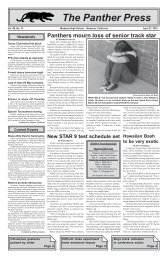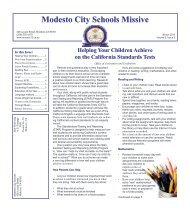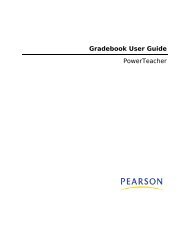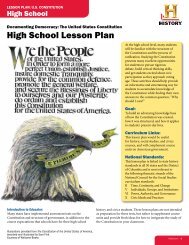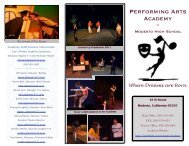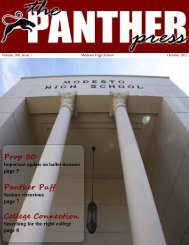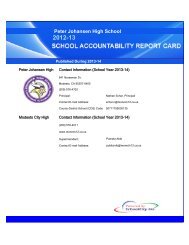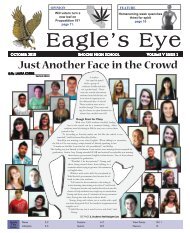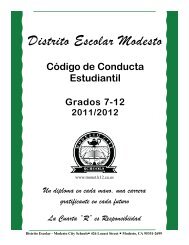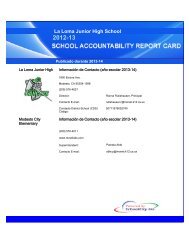Properties of Kites and Trapezoids
Properties of Kites and Trapezoids
Properties of Kites and Trapezoids
You also want an ePaper? Increase the reach of your titles
YUMPU automatically turns print PDFs into web optimized ePapers that Google loves.
LESSON<br />
6-6<br />
<strong>Properties</strong> <strong>of</strong> <strong>Kites</strong> <strong>and</strong> <strong>Trapezoids</strong><br />
Lesson Objectives (p. 427):<br />
______________________________________________________________<br />
______________________________________________________________<br />
Vocabulary<br />
1. Kite (p. 427): ___________________________________________________<br />
______________________________________________________________<br />
2. Trapezoid (p. 429): ______________________________________________<br />
______________________________________________________________<br />
3. Base <strong>of</strong> a trapezoid (p. 429): _______________________________________<br />
______________________________________________________________<br />
4. Leg <strong>of</strong> a trapezoid (p. 429): ________________________________________<br />
______________________________________________________________<br />
5. Base angle <strong>of</strong> a trapezoid (p. 429): __________________________________<br />
______________________________________________________________<br />
6. Isosceles trapezoid (p. 429): _______________________________________<br />
______________________________________________________________<br />
7. Midsegment <strong>of</strong> a trapezoid (p. 431): _________________________________<br />
______________________________________________________________<br />
Copyright © by Holt, Rinehart <strong>and</strong> Winston. 137 Geometry<br />
All rights reserved.
LESSON<br />
6-6<br />
<strong>Properties</strong> <strong>of</strong> <strong>Kites</strong> <strong>and</strong> <strong>Trapezoids</strong><br />
Lesson Objectives (p. 427):<br />
______________________________________________________________<br />
use properties <strong>of</strong> kites to solve problems; use properties <strong>of</strong> trapezoids to<br />
______________________________________________________________<br />
solve problems.<br />
Vocabulary<br />
1. Kite (p. 427): ___________________________________________________<br />
a quadrilateral with exactly two pairs <strong>of</strong> congruent sides.<br />
______________________________________________________________<br />
2. Trapezoid (p. 429): ______________________________________________<br />
a quadrilateral with exactly one pair <strong>of</strong> parallel sides.<br />
______________________________________________________________<br />
3. Base <strong>of</strong> a trapezoid (p. 429): one _______________________________________<br />
<strong>of</strong> the two parallel sides <strong>of</strong> the trapezoid.<br />
______________________________________________________________<br />
4. Leg <strong>of</strong> a trapezoid (p. 429): ________________________________________<br />
one <strong>of</strong> the two nonparallel sides <strong>of</strong> the trapezoid.<br />
______________________________________________________________<br />
5. Base angle <strong>of</strong> a trapezoid (p. 429): __________________________________<br />
one <strong>of</strong> a pair <strong>of</strong> consecutive angles whose<br />
______________________________________________________________<br />
common side is a base <strong>of</strong> the trapezoid.<br />
6. Isosceles trapezoid (p. 429): _______________________________________<br />
a trapezoid in which the legs are congruent.<br />
______________________________________________________________<br />
7. Midsegment <strong>of</strong> a trapezoid (p. 431): _________________________________<br />
the segment whose endpoints are the<br />
______________________________________________________________<br />
midpoints <strong>of</strong> the legs <strong>of</strong> the trapezoid.<br />
Copyright © by Holt, Rinehart <strong>and</strong> Winston. 137 Geometry<br />
All rights reserved.
LESSON 6-6 CONTINUED<br />
Key Concepts<br />
8. Theorems—<strong>Properties</strong> <strong>of</strong> <strong>Kites</strong> (p. 427):<br />
THEOREM HYPOTHESIS CONCLUSION<br />
6-6-1<br />
6-6-2<br />
9. Theorems—Isosceles <strong>Trapezoids</strong> (p. 429):<br />
THEOREM DIAGRAM EXAMPLE<br />
6-6-3<br />
6-6-4<br />
6-6-5<br />
Copyright © by Holt, Rinehart <strong>and</strong> Winston. 138 Geometry<br />
All rights reserved.
LESSON 6-6 CONTINUED<br />
Key Concepts<br />
8. Theorems—<strong>Properties</strong> <strong>of</strong> <strong>Kites</strong> (p. 427):<br />
THEOREM HYPOTHESIS CONCLUSION<br />
6-6-1 If a quadrilateral is a kite,<br />
then its diagonals are<br />
perpendicular.<br />
(kite → diags. )<br />
6-6-2 If a quadrilateral is a kite,<br />
then exactly one pair <strong>of</strong><br />
opposite angles are<br />
congruent.<br />
(kite → one pair opp. )<br />
9. Theorems—Isosceles <strong>Trapezoids</strong> (p. 429):<br />
Copyright © by Holt, Rinehart <strong>and</strong> Winston. 138 Geometry<br />
All rights reserved.<br />
A<br />
A<br />
B<br />
D<br />
B<br />
D<br />
C<br />
C<br />
AC BD<br />
B D<br />
A C<br />
THEOREM DIAGRAM EXAMPLE<br />
6-6-3 If a quadrilateral is an<br />
isosceles trapezoid, then<br />
each pair <strong>of</strong> base angles<br />
are congruent.<br />
(isosc. trap. → base )<br />
6-6-4 If a trapezoid has one pair<br />
<strong>of</strong> congruent base angles,<br />
then the trapezoid is<br />
isosceles.<br />
(trap. with pair base<br />
→ isosc. trap.)<br />
6-6-5 A trapezoid is isosceles if<br />
<strong>and</strong> only if its diagonals<br />
are congruent.<br />
(isosc. trap. ↔ diags. )<br />
B<br />
C<br />
A D<br />
B<br />
C<br />
A D<br />
B<br />
C<br />
A D<br />
A D<br />
B C<br />
ABCD is<br />
isosceles.<br />
AC<br />
DB<br />
↔<br />
ABCD is<br />
isosceles.
LESSON 6-6 CONTINUED<br />
10. Theorem 6-6-6—Trapezoid Midsegment Theorem (p. 431):<br />
Theorem 6-6-6<br />
11. Get Organized Write the missing terms in the unlabeled sections. Then write<br />
the definition <strong>of</strong> each term. (p. 431)<br />
Parallelograms<br />
Quadrilaterals<br />
Rectangles Squares<br />
Rhombuses<br />
Copyright © by Holt, Rinehart <strong>and</strong> Winston. 139 Geometry<br />
All rights reserved.
LESSON 6-6 CONTINUED<br />
10. Theorem 6-6-6—Trapezoid Midsegment Theorem (p. 431):<br />
Theorem 6-6-6 The midsegment <strong>of</strong> a trapezoid<br />
is parallel to each base, <strong>and</strong><br />
its length is one half the sum<br />
<strong>of</strong> the lengths <strong>of</strong> the bases.<br />
XY BC , XY AD <br />
XY 1<br />
(BC AD)<br />
2<br />
B C<br />
X Y<br />
A D<br />
11. Get Organized Write the missing terms in the unlabeled sections. Then write<br />
the definition <strong>of</strong> each term. (p. 431)<br />
Rectangles<br />
quads with<br />
4 rt. <br />
Parallelograms<br />
quads<br />
with 2 pair <strong>of</strong> || sides<br />
Squares<br />
quads with 4 rt. <br />
<strong>and</strong> 4 ≅ sides<br />
Quadrilaterals<br />
Rhombuses<br />
quads with<br />
4 ≅ sides<br />
polygons<br />
with 4 sides<br />
<strong>Trapezoids</strong>:<br />
quads with exactly<br />
1 pair <strong>of</strong> || sides<br />
Isosceles<br />
trapezoid: traps.<br />
with ≅ legs<br />
<strong>Kites</strong>: quads<br />
with exactly 2<br />
pairs <strong>of</strong> congruent<br />
sides<br />
Copyright © by Holt, Rinehart <strong>and</strong> Winston. 139 Geometry<br />
All rights reserved.



